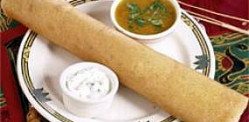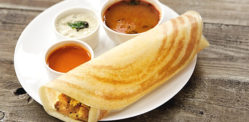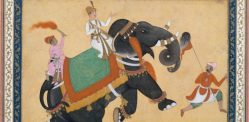In the pantheon of Indian cuisine, few dishes command the reverence and adoration bestowed upon dosa.
A culinary masterpiece originating from South India, dosa transcends mere sustenance, embodying centuries of tradition, innovation and cultural heritage.
As its aroma wafts through bustling streets and serene kitchens alike, dosa captivates palates with its delicate crispness, tantalising flavours and timeless allure.
But it has had a long history.
Join us as we delve into the annals of culinary history, tracing this food’s humble beginnings to its status as a cherished symbol of South Indian gastronomy.
Ancient Roots
The origins can be traced back to ancient South India, particularly in the present-day states of Karnataka, Tamil Nadu, Andhra Pradesh and Kerala.
Although the origins are not precisely documented, historical evidence suggests that dosa-like dishes have been consumed in this region for centuries.
One of the earliest references to a dosa-like dish can be found in ancient Tamil literature dating back to the 1st century AD.
These early versions were made from ground rice and were called ‘dosai’ in Tamil.
These early dosais were likely simple rice pancakes cooked on a hot griddle or stone.
How did they Evolve?
Over time, the dosa evolved and one of the main advancements was the introduction of fermentation.
This likely occurred around the medieval period. Fermentation involves allowing the batter made from rice and urad daal to ferment overnight.
This process not only enhances the flavour but also increases its nutritional value by breaking down complex carbohydrates and making nutrients more accessible.
The fermentation process is in line with the principles of Ayurveda.
Ayurveda emphasises the importance of fermented foods for gut health and digestion. The incorporation of fermented batter into the diet may have been influenced by Ayurvedic principles.
As it gained popularity across South India, different regions developed their own variations of the dish, adding diversity.
Over time, recipes continued to evolve with the introduction of new ingredients and cooking techniques.
For instance, the use of different types of rice, such as parboiled rice or brown rice, may have influenced the texture and flavour of dosa.
Additionally, innovations like the rava dosa, made from semolina, or the Neer dosa, made from rice batter without fermentation, added further diversity to this popular dish.
Different Types
Across India, there are different types of dosa, each with its own set of ingredients and preparation methods.
Plain Dosa
This is the basic and most traditional form. It’s made from a fermented batter of rice and urad daal and is cooked on a hot griddle until it becomes golden brown and crispy on the edges.
It is typically served with chutney and sambar.
Masala Dosa
Perhaps the most famous variation, it features a filling of spiced potatoes wrapped inside the dosa.
The batter is spread thinly on the griddle, and a layer of the potato filling is added before folding into a cylindrical shape. It’s served with chutney and sambar.
Onion Dosa
This one is made by adding finely chopped onions to the batter before cooking.
The onions add a sweet and savoury flavour and create a delicious caramelisation when cooked.
Rava Dosa
Rava dosa is made from a batter of semolina, rice flour and all-purpose flour, which gives it a crispy texture.
Unlike traditional batter, rava batter doesn’t require fermentation.
Mysore Masala Dosa
Mysore masala dosa is similar to the popular masala version but is distinguished by the addition of a spicy red chutney spread on the inner surface before adding the potato filling.
This chutney, made from red chillies and garlic, gives the dish a distinctive flavour and a reddish hue.
Set Dosa
Set dosa is thicker and softer compared to regular one.
It’s made from a slightly different batter that includes a higher proportion of urad daal to rice.
It is typically served in a set of two or three and is accompanied by chutney and sambar.
Neer Dosa
Neer dosa is a speciality from the coastal regions of Karnataka.
The batter is made from rice and water, without fermentation. The dosa is thin, soft, and translucent, with a delicate texture. It’s often served with coconut chutney or a spicy curry.
Pesarattu
Native to Andhra Pradesh, this version is made from a batter of moong daal and rice, which gives it a green colour.
Pesarattu is typically served with upma and ginger chutney.
Globalisation
Dosa has grown to become one of India’s most popular foods, enjoyed all over the world and several factors have contributed to its global spread.
One of the biggest reasons is Indian-origin people living in various parts of the world.
As Indian immigrants settled in different countries, they introduced their culinary traditions, including dosa, to local communities.
The increase in travel has exposed non-Indian communities to Indian cuisine.
Indian restaurants have also expanded internationally, bringing the dish to new markets. These restaurants often offer a variety of options, catering to local tastes and preferences while maintaining the authenticity of the dish.
Chefs and food enthusiasts worldwide have experimented with dosa, creating fusion variations and incorporating local ingredients and flavours.
This culinary innovation has introduced dosa to new audiences and expanded its appeal beyond traditional South Indian cuisine lovers.
Food trends have also contributed.
The growing popularity of vegetarian and vegan diets, as well as the demand for gluten-free options, has boosted the food’s appeal.
India’s Love for Dosa
In a report, Swiggy delivered 29 million dosas between February 25, 2023 – February 25, 2024. This is 122 dosas per minute on average.
The dosa capital of India is Bengaluru, with double the amount of orders than Delhi, Mumbai and Kolkata combined.
Chandigarh, which is well-known for its buttery parathas, embraced masala dosa as its new favourite food.
It was also among the most ordered dishes in Ranchi, Coimbatore, Pune, and Bhopal.
One Swiggy user from Coimbatore ordered 447 portions over the past year.
During major events such as the cricket World Cup, the IPL and Ramadan, it was found to be the most frequently ordered dish.
Additionally, during Navratri, it was the most popular vegetarian dish.
The prime time for dosa cravings was during breakfast hours, followed by dinner.
Chennai emerged as the city with the strongest affinity towards dosas for dinner, while Hyderabad has played a significant role in solidifying dosa’s position as a favourite snack-time dish.
From its modest origins in ancient South India to its global prominence in contemporary cuisine, dosa stands as a testament to the resilience of culinary traditions and the enduring appeal of flavours that transcend borders.
Whether enjoyed on a bustling street corner in Chennai or savoured in the comfort of our homes halfway across the globe, dosa remains a timeless symbol of culinary craftsmanship and cultural heritage.


































































